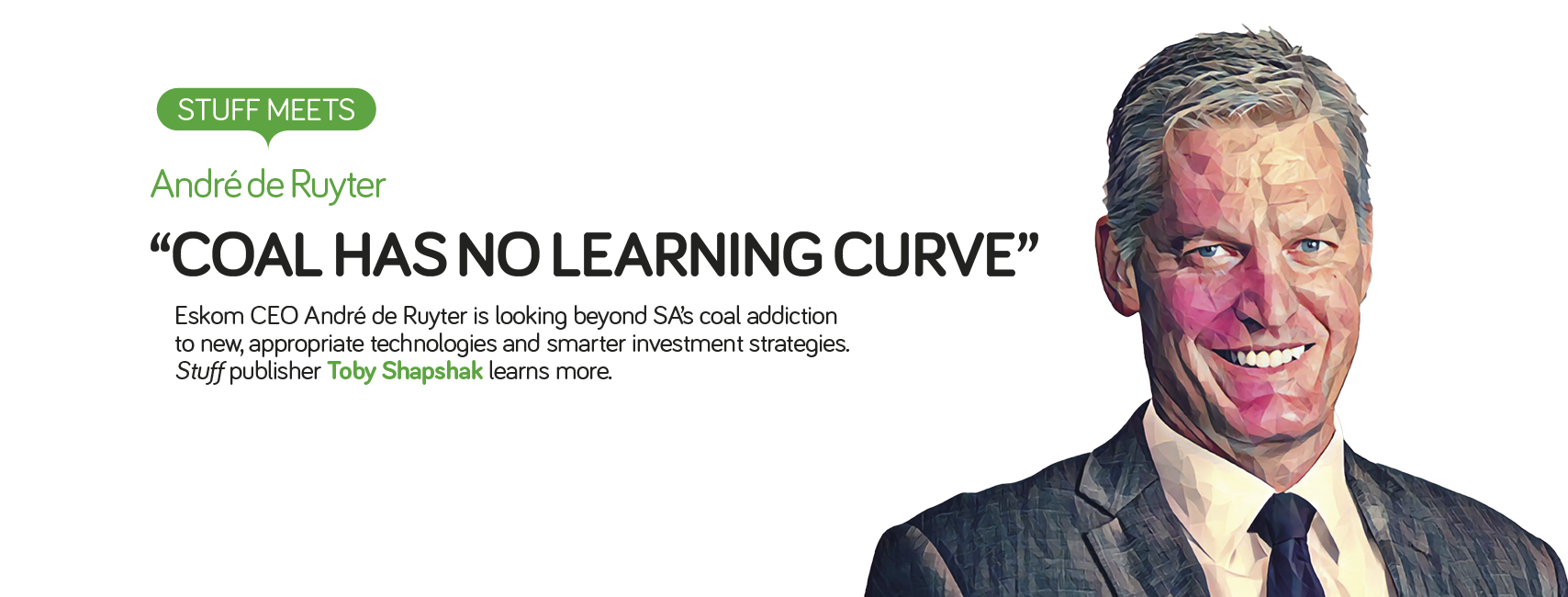Eskom CEO André de Ruyter is looking beyond SA’s coal addiction to new, appropriate technologies and smarter investment strategies. Stuff publisher Toby Shapshak learns more.
 André de Ruyter is the most important businessman in South Africa today. If the Eskom CEO can’t deal with its debt, its notorious inefficiency and the load-shedding problems, the whole country will suffer. It wasn’t helped by an explosion in Medupi in August which caused an estimated R2bn in damages and will take two years to repair.
André de Ruyter is the most important businessman in South Africa today. If the Eskom CEO can’t deal with its debt, its notorious inefficiency and the load-shedding problems, the whole country will suffer. It wasn’t helped by an explosion in Medupi in August which caused an estimated R2bn in damages and will take two years to repair.
De Ruyter is planning to evolve Eskom into a modern power utility, lessening its dependence on coal and embracing cheaper technologies in renewables, while keeping an eye on the upcoming EU carbon border tax.
Faced with an enormous R400-billion in debt from state capture and 66% overstaffed, according to a 2016 World Bank policy research working paper, Eskom is in a deep financial hole – one which threatens to pull the country down with it.
De Ruyter, according to the Sunday Times, was the 28th candidate willing to say yes to the most poisoned chalice of a job in the country – even more so than that of Bafana or Springbok coach. He must have known he would be vilified and his reputation could be damaged, but he took the job anyway. The accusations – including racism allegations by his since dismissed Eskom chief procurement officer Solly Tshitangano, who was fired for dubiously advancing the interests of a supplier over Eskom.
But de Ruyter is strangely optimistic about what can be achieved with Eskom.
“I think we are in a fortunate position that we are faced with an array of power stations that are rapidly
approaching the end of life. They’ve had a very hard life, they’ve been run far harder than norms would dictate, and they haven’t been maintained properly,” he said.
The “incredibly expensive” estimate to bring them into full compliance from an environmental point of view is about R300-billion. “And of course, you earn no return on that money. Youdon’tbuyanynew generation capacity.” Even more concerning, the costs of coal are now going to become more expensive, because of the environmental abatement costs and increasing costs of carbon emissions. Meanwhile, competing technologies are becoming ever more affordable.
“And if you’re a businessperson, which I think I am, you look at this, and you say: well, do we invest R300-billion in environmental compliance costs? Do we spend more time on extending the life of our existing fleet? Or do you see this as an ironic opportunity to pivot the industry away from carbon to a cleaner, greener future?
“And by the way, in the process attract significant concessional funding – from international lenders who are very concerned about climate change.”
Read more: Stuff Load Shedding Guide 2021
Even more disastrous is that insurance firms are increasingly less willing to insure fossil fuel polluters, even if Eskom could secure funding. “You will struggle to ensure your assets because of the adverse climate events”.
South Africa generates an unusually high percentage of its power from coal, or 77% – compared to the global average of 36%. This is partly due to the abundance of coal resources, as much as the lack of rivers for hydropower or oil like neighbouring Angola.
“To think that there is a case for South African coal exceptionalism, and to think that we can ignore global trends, is a challenge, a paradigm that we have to shift,” he says.
Meanwhile, the cost of renewable energy and battery storage is plunging down 60% from 2015 to 2020 and is expected to further decrease by another 30% by 2025.
International funding opportunities abound. De Ruyter quotes figures of $40.5-trillion in total global so-called environmental, social and governance (ESG) assets under management in 2020. This is part of his Eskom’s Just Energy Transition (JET) Plans proposal presented to the Presidential Climate Commission in July 2021.
“The Stone Age didn’t end because of a lack of stones. Nor will the coal age end because of a lack of coal. The fact that we’ve got a resource doesn’t mean we have to fully utilise it, particularly not as there’s a better resource available,” says de Ruyter, ever the pragmatic businessman.
Coal does not have a “learning curve” de Ruyter told Stuff, while new technologies like photo-voltaic panels which capture the sun’s energy are continuously growing.
“It’s like Moore’s law in computing, that the [solar] costs have come down,” de Ruyter argues, citing Intel co-founder Gordon Moore’s famous law that every 18 months processors became twice as powerful, but cost half as much.
Former US vice-president Al Gore first mentioned this in 2011 when he spoke at the Discovery Leadership Conference – although his observations at the time were overshadowed by a slipped iPhone comment.
De Ruyter may seem philosophical about Eskom’s seemingly insurmountable challenges, but he is clearly not naïve.
“Great challenges in human history have often given rise to great opportunities and great developments. If you look at the Second World War. It gave rise to a whole bunch of technological innovations that we still benefit from today. The same with Covid. The same with the energy crisis in South Africa.
“If we had built the power stations that Eskom had suggested 15 years ago, we would still be bound to coal for an extended period of time, because we would probably operate those power stations until the end of their lives.“But now, because ironically we didn’t invest, we have load shedding, and we have a shortage of generation capacity that coincides with this opportunity of ‘let’s see what we can do to turn this challenge into an opportunity.’
He adds: “And that’s the great thing about the challenge we currently face.”
An additional advantage is that South Africa is a great destination for carbon mitigation, he adds, especially as investors are incentivised to find high-impact projects as part of their key performance areas. Helpfully, South Africa offers attractive carbon emissions abatement costs of $7 per ton versus $120 to $400 a ton in developed countries.
Meanwhile, unshackled from its coal-fired fixation, Eskom has developed a containerised, modular micro-grid, which is “really, really exciting,” de Ruyter says. “It’s an old shipping container, so it’s recycling.”
The whole set-up fits into a shipping container, which can be transported by truck to remote villages. It has collapsible awnings with solar panels on them and can generate enough electricity to supply 20 to 30 homes. The batteries, inverters and controllers are stored inside the robust container.
“If you think that there are 13% of South Africans who still don’t have access to electricity, this is a great opportunity to show off this type of appropriate technology.”
“I think we are very often seduced by the new, sexier technology. We want to compete with a moon-shot when we’ve got opportunities for appropriate technology to solve some of our own challenges in a very affordable, robust and resilient way. And that is where I think we should focus as a nation.”



